Sunday Poster Session
Category: Liver
P1309 - From Nodules to Neoplasms: The Diagnostic Odyssey of Hepatic Epithelioid Hemangioendothelioma (HEHE)
Sunday, October 27, 2024
3:30 PM - 7:00 PM ET
Location: Exhibit Hall E

Has Audio

Dakota Bigham, MD
University of Texas Health San Antonio
San Antonio, TX
Presenting Author(s)
Dakota Bigham, MD1, Apeksha Agarwal, MD1, Christopher Rhodes, DO1, Jan Petrasek, MD, PhD2, Fabian Rodas, MD3, Andres Gomez-Aldana, MD2, Carmen Landaverde, MD4, Lisa Pedicone, PhD2, Eric J. Lawitz, MD5, Fred Poordad, MD2, Eugenia Tsai, MD2
1University of Texas Health San Antonio, San Antonio, TX; 2Texas Liver Institute, San Antonio, TX; 3The Texas Liver Institute, San Antonio, TX; 4Texas Liver Institute, Austin, TX; 5The Texas Liver Institute, University of Texas Health, San Antonio, TX
Introduction: Hepatic epithelioid hemangioendothelioma (HEHE) is a rare vascular endothelial cell tumor, with an incidence rate of 1-2 cases per million. Malignancy potential of HEHE is unpredictable and clinical course varies widely, ranging from long-term survival without treatment to rapidly progressive course with fatal outcome.
Case Description/Methods: A 48-year-old male with no medical history was found to have isolated elevation of ALP (131 U/L; normal 34-104 U/L) on routine lab work. Due to lack of symptoms, PCP initially deferred further workup. ALP remained elevated (282 U/L) 4 months later so contrasted MRI was ordered and showed a 4.2 cm nodular mass with retraction concerning for cholangiocarcinoma. Biopsy of the right and left hepatic lobes revealed tumor cells positive for CD31, CAMTA1 and ERG consistent with bilateral HEHE (Figure1A and 1B). PET scan showed increased uptake in the right hepatic lobe without extrahepatic disease (Figure 1C). MRI at our institution revealed mass was confluent and 16 cm, rather than 4.2 cm in size. Due to extent of disease, surgical resection was not an option. Treatment with bevacizumab was initiated but discontinued after four doses due to lack of response. During this period, liver function worsened: AST (69 U/L; normal< 35), ALT (55 U/L; normal< 46), ALP (358 U/L), total bilirubin (3.2 mg/dL; normal 0.2-1.2 mg/dL), INR (1.4; normal 0.8-1.2), and platelets (214 K/mcL; normal 140-377 K/mcL) and he developed ascites. Patient was evaluated and approved for liver transplantation; he is currently active on the waitlist.
Discussion: HEHE is a malignant vascular tumor featuring epithelioid and histiocyte-like endothelial cells within a fibrotic matrix. Diagnosis relies on pathology aided by immunohistochemical markers CD31, CD34, CD10, VIII-related antigen, and vimentin. No standardized treatment exists but liver transplantation is a reasonable option. Studies have shown a 5-year posttransplant disease-free survival rate of 79.4% and a recurrence rate of 24.8%. Factors that have been shown to increase the risk of disease recurrence include shortened pretransplant waiting times of less than 120 days, macrovascular invasion, and involvement of hilar lymph nodes.
Chronic liver disease and hepatic malignancies do not present with symptoms until late stages at which point treatment options are limited. This case highlights the importance of early evaluation of abnormal liver enzymes, even if isolated and mild.

Disclosures:
Dakota Bigham, MD1, Apeksha Agarwal, MD1, Christopher Rhodes, DO1, Jan Petrasek, MD, PhD2, Fabian Rodas, MD3, Andres Gomez-Aldana, MD2, Carmen Landaverde, MD4, Lisa Pedicone, PhD2, Eric J. Lawitz, MD5, Fred Poordad, MD2, Eugenia Tsai, MD2. P1309 - From Nodules to Neoplasms: The Diagnostic Odyssey of Hepatic Epithelioid Hemangioendothelioma (HEHE), ACG 2024 Annual Scientific Meeting Abstracts. Philadelphia, PA: American College of Gastroenterology.
1University of Texas Health San Antonio, San Antonio, TX; 2Texas Liver Institute, San Antonio, TX; 3The Texas Liver Institute, San Antonio, TX; 4Texas Liver Institute, Austin, TX; 5The Texas Liver Institute, University of Texas Health, San Antonio, TX
Introduction: Hepatic epithelioid hemangioendothelioma (HEHE) is a rare vascular endothelial cell tumor, with an incidence rate of 1-2 cases per million. Malignancy potential of HEHE is unpredictable and clinical course varies widely, ranging from long-term survival without treatment to rapidly progressive course with fatal outcome.
Case Description/Methods: A 48-year-old male with no medical history was found to have isolated elevation of ALP (131 U/L; normal 34-104 U/L) on routine lab work. Due to lack of symptoms, PCP initially deferred further workup. ALP remained elevated (282 U/L) 4 months later so contrasted MRI was ordered and showed a 4.2 cm nodular mass with retraction concerning for cholangiocarcinoma. Biopsy of the right and left hepatic lobes revealed tumor cells positive for CD31, CAMTA1 and ERG consistent with bilateral HEHE (Figure1A and 1B). PET scan showed increased uptake in the right hepatic lobe without extrahepatic disease (Figure 1C). MRI at our institution revealed mass was confluent and 16 cm, rather than 4.2 cm in size. Due to extent of disease, surgical resection was not an option. Treatment with bevacizumab was initiated but discontinued after four doses due to lack of response. During this period, liver function worsened: AST (69 U/L; normal< 35), ALT (55 U/L; normal< 46), ALP (358 U/L), total bilirubin (3.2 mg/dL; normal 0.2-1.2 mg/dL), INR (1.4; normal 0.8-1.2), and platelets (214 K/mcL; normal 140-377 K/mcL) and he developed ascites. Patient was evaluated and approved for liver transplantation; he is currently active on the waitlist.
Discussion: HEHE is a malignant vascular tumor featuring epithelioid and histiocyte-like endothelial cells within a fibrotic matrix. Diagnosis relies on pathology aided by immunohistochemical markers CD31, CD34, CD10, VIII-related antigen, and vimentin. No standardized treatment exists but liver transplantation is a reasonable option. Studies have shown a 5-year posttransplant disease-free survival rate of 79.4% and a recurrence rate of 24.8%. Factors that have been shown to increase the risk of disease recurrence include shortened pretransplant waiting times of less than 120 days, macrovascular invasion, and involvement of hilar lymph nodes.
Chronic liver disease and hepatic malignancies do not present with symptoms until late stages at which point treatment options are limited. This case highlights the importance of early evaluation of abnormal liver enzymes, even if isolated and mild.

Figure: Figure 1. Hepatic epithelioid hemangioendothelioma (HEHE) diagnosed based on (A) Liver biopsy section showing cords and nest of tumor cells in a myxohyaline background (H&E, magnification 100x). (B) Liver biopsy displaying neoplastic cells expressing CD31 (magnification 100x); and (C) PET/CT showing marked heterogenous FDG uptake in the right hepatic lobe without extrahepatic disease.
Disclosures:
Dakota Bigham indicated no relevant financial relationships.
Apeksha Agarwal indicated no relevant financial relationships.
Christopher Rhodes indicated no relevant financial relationships.
Jan Petrasek indicated no relevant financial relationships.
Fabian Rodas indicated no relevant financial relationships.
Andres Gomez-Aldana indicated no relevant financial relationships.
Carmen Landaverde indicated no relevant financial relationships.
Lisa Pedicone indicated no relevant financial relationships.
Eric Lawitz: 89Bio – Consultant, Grant/Research Support. Akero – Consultant, Grant/Research Support. Alnylam – Consultant, Grant/Research Support. Amgen – Consultant, Grant/Research Support. AstraZeneca – Consultant, Grant/Research Support. Axcella Health – Consultant, Grant/Research Support. Boehringer Ingelheim – Consultant, Grant/Research Support. Bristol Myers Squibb – Consultant, Grant/Research Support. CymaBay, a Gilead Sciences Company – Consultant, Grant/Research Support. CytoDyn – Consultant, Grant/Research Support. DSM – Consultant, Grant/Research Support. Durect – Consultant, Grant/Research Support. Eli Lilly – Consultant, Grant/Research Support. Enanta – Consultant, Grant/Research Support. Enyo – Consultant, Grant/Research Support. Exalenz – Consultant, Grant/Research Support. Galectin – Consultant, Grant/Research Support. Galmed – Consultant, Grant/Research Support. Genentech – Consultant, Grant/Research Support. Genfit – Consultant, Grant/Research Support. Gilead Sciences, Inc. – Consultant, Grant/Research Support. GSK – Consultant, Grant/Research Support. Hanmi – Consultant, Grant/Research Support. Hightide – Consultant, Grant/Research Support. Intercept – Consultant, Grant/Research Support. Inventiva – Consultant, Grant/Research Support. Ipsen – Consultant, Grant/Research Support. Janssen – Consultant, Grant/Research Support. Madrigal – Consultant, Grant/Research Support. Merck & Co – Consultant, Grant/Research Support. NGM – Consultant, Grant/Research Support. Northsea – Consultant, Grant/Research Support. Novartis – Consultant, Grant/Research Support. Novo Nordisk – Consultant, Grant/Research Support. Pfizer – Consultant, Grant/Research Support. Poxel Co – Consultant, Grant/Research Support. Roche – Consultant, Grant/Research Support. Sagimet – Consultant, Grant/Research Support. Terns – Consultant, Grant/Research Support. Viking – Consultant, Grant/Research Support. Zydus – Consultant, Grant/Research Support.
Fred Poordad indicated no relevant financial relationships.
Eugenia Tsai indicated no relevant financial relationships.
Dakota Bigham, MD1, Apeksha Agarwal, MD1, Christopher Rhodes, DO1, Jan Petrasek, MD, PhD2, Fabian Rodas, MD3, Andres Gomez-Aldana, MD2, Carmen Landaverde, MD4, Lisa Pedicone, PhD2, Eric J. Lawitz, MD5, Fred Poordad, MD2, Eugenia Tsai, MD2. P1309 - From Nodules to Neoplasms: The Diagnostic Odyssey of Hepatic Epithelioid Hemangioendothelioma (HEHE), ACG 2024 Annual Scientific Meeting Abstracts. Philadelphia, PA: American College of Gastroenterology.
